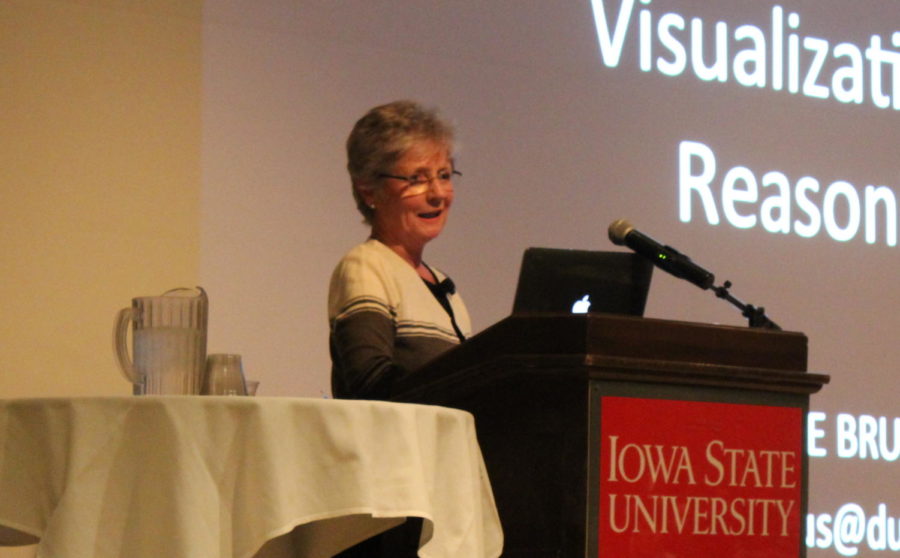Wired! Lab founder explains how digital modelling revolutionized historical documentation
Caroline Bruzelius speaks to students and Ames community members in the Sun Room of the Memorial Union on March 27, 2017. Bruzelius spoke about how digital technologies are influencing and broadening the humanities during the annual Benson Memorial Lecture in Literature, Science and the Arts.
March 27, 2017
Caroline Bruzelius, founder of the Wired! Lab at Duke University, works with technological tools in order to remodel structures that bore some archaeological significance that were lost over the centuries.
She spoke on the intersection of history and modern technology Monday night in a lecture dubbed Apps, Maps, and Models – The Digital Revolution and History.
“Ideally what would be nifty is to create an app that will give the experience what it would look like in a museum, to offer that virtual experience,” Bruzelius said.
She presented the audience with texts and visuals representing the middle ages, attesting to the hypocrisy of avaricious Franciscan and Dominican friars as they strategically gained wealth from dying aristocrats.
Bruzelius displayed an image where a wealthy merchant lies on his deathbed, uttering his will to a notary, and next to the dying man stood a friar, proposing salvation in exchange for gold.
The accumulated wealth of the friars yielded the expansions of the covenants, whereby monumental cloisters and hallways were constructed.
“We asked ourselves, ‘What will happen if we took one of these nifty new tools and made it 3-D?’” Bruzelius said. “Making a model showed us that the critics, the anti-fraternal critics in the 14th century were absolutely right: these were enormous buildings!”
Bruzelius further presented a gallery footage that showcased a museum opening. In the footage, visitors kept walking past the magnificent structures, antiquities and archaic designs on exhibit.
“I think we get the point by now,” Bruzelius said. “How can we change this?”
Bruzelius showcased a technological painting software inserted in the museum that allows visitors to interact by painting virtual antiquities and monuments. In one of the images, a young boy played with the technology in the museum, which, according to Bruzelius, could restore the appreciation in the arts and history.
Furthermore, another project that she worked on with her team featured the remodeling of the choir screen in the Church of Santa Chiara in Naples. The site was significant due to its commemoration of the tomb of King Robert the Wise, who died in 1343. Bruzelius said it was destroyed in the bombings of World War II, hence losing its original structure.
“We lost a huge part of the artistic patrimony of this cite during the war,” Bruzelius said.
Bruzelius and her team remodeled the building with a ground-penetrating radar. It revealed the actual dimensions of the original structure, and from their onward, they created imaginations of what it could have looked like in the 14th century.
“What did we do? We took the evidence and went to the bar over a cup of coffee,” Bruzelius said.
She pulled up images of sketches, stained with coffee on chapels and hallways. Once they imagined the platforms and the structures, they remodeled the Chiara in Naples, but this time, it included a second upper platform that was lost to the bombings, stretched with arched hallways, in front of the tomb of Robert the Wise.
“We took to Naples, we took it to the lion’s den. I expected we would be savagely ripped to shred,” Bruzelius said. “In fact, they were very enthusiastic, and a number of people working on sculptural fragments wanted to use our model to test possible locations.”
In a smaller and recent project, she worked with a few colleagues in Venice in order to restore and preserve cisterns and wells of its middle ages. The project has not been approached at a professional angle yet, but Bruzelius is hopeful it will.
“As historians, the object is the document. Our particular culture is well suited with documents that have to do with modeling and visualization,” Bruzelius said.







